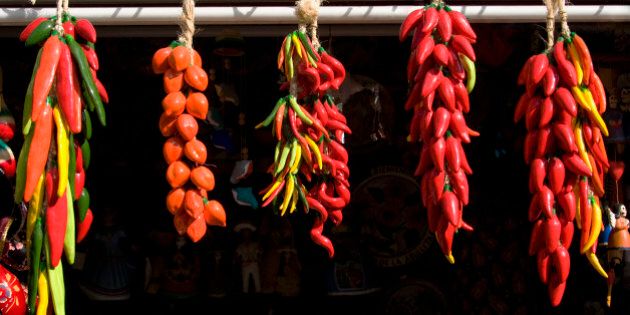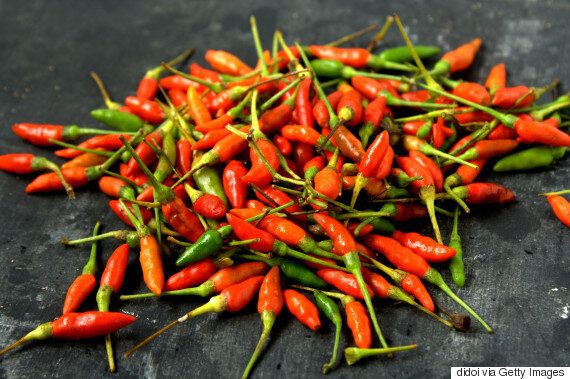

Chillies. People tend to love them, hate them or flat-out refuse to deal with them. (Usually a friendship group will have a representative from each camp, making going out to Thai difficult, but that's another story.)
For Neil Smith, founder and owner of The Hippy Seed Company, chillies are a way of life -- and the hotter, the better.
Smith not only met his wife through a mutual interest in chillies, he also grows hundreds of varieties through his business and was even the Guinness World Record holder for the world's hottest chilli between March 2011 and November 2013, with his frighteningly named Butch T Scorpion. (The coveted title is now held by The Carolina Reaper HP22B.)
In short, the man knows a thing or two about chillies, and sells over 500 varieties of seeds around the world. And Aussie spice lovers can rejoice, because Australia is the perfect place to grow them.
"I’ve been eating chillies since I was about 16, and have run this company for nearly 20 years," Smith told The Huffington Post Australia. "I do this for a living -- sourcing seeds to supply to Australians -- and it's an absolute dream.
"They tend to grow really well in Australia, I think due to our climate, and if you grow them in the tropics, they will actually grow all year around.
"For the more temperate climates, where the temperature drops below 20 degrees, they will look like they are dead [in the colder months] and lose their leaves, and then in spring they come back.
"But the exciting thing is, anything you can get around the world, you can now get in Australia."

The world's hottest chilli, The Carolina Reaper.
Smith actually estimates there to be around three and a half thousand chilli varieties worldwide -- not including the crosses and creations people are now experimenting with -- and says cooking shows have prompted many Australians to venture outside their normal chilli preferences.
"I think a lot of the chilli plants sold in Australia in shops like Bunnings, for instance, tend to be more ornamental," Smith said. "They all have that capsicum-my type flavour.
"I don't think a lot of people realise how different many flavours chillis can have. We tried one the other day and it honestly tasted like pineapple. Then that flavour goes away and you get whacked with a bit of heat.
"Another one tasted just like a string bean. There are all sorts of flavours out there.
"But in saying that, if you’re not used to the heat, you can't usually taste the flavours. You're just sitting there with your eyes watering worrying about what's going on."
For this reason, it's not the best idea to go from zero to hero when it comes to chilli experimentation.
For those who enjoy a mild chilli, Smith recommends trying the Malawi Piquante pepper.
"These are quite mild and they grow beautifully -- up to 10 feet tall, and you can grow them over an archway," Smith said.
"For a mid-heat, you can't go past a variety of Bird's eye. You can actually buy those in shops such as Woollies or you can grow them yourselves. You can even just pull the seeds out from a store-bought one and grow it like that."
On the hotter end of the scale, Smith says it really depends how hot you want to get.
"Okay, so for someone who likes a hot chilli, a habanero of some kind would be good. Probably a yellow one, as they are really nicely flavoured," Smith said.
"The next step up from there would be probably the bhut jolokia (ghost pepper), and if you want to get really hectic, the Butch T or a Trinidad Scorpion -- maybe a chocolate scorpion -- would be ideal."

Bird's eye chillies.
To give you an idea of the levels of hotness we're talking about, there is a handy measuring tool called the Scoville Heat Unit (SHU).
For instance, a jalapeño has a SHU rating of about 2,500–5,000, while a bird's eye chilli has a rating of about 30,000.
On the other end of the scale, the current world record holder The California Reaper has a SHU of 1,569,300. Smith's creation, the Butch T Scorpion, sits at 1,463,700.
All together now: OUCH.
So what do you do if you exceed your chilli limit by accident?
"Sip milk or eat cheese. What you're after is fatty products," Smith advised. "Capsaicin is actually an oil, so if you try and get rid of the heat with water, coke or beer, it actually just moves it around and makes it worse.
"With fatty products, the oil binds to the fat, which helps. Just don't drink the milk too quickly or you'll end up being sick, and that's even worse."
For those who want to add some chilli to their cooking, Smith advised it's actually better to do so after the dish has been prepared, not during.
"It is always better to put it on the food rather than cook with it in the food," Smith said. "Because if you cook with chilli, the flavour goes through the whole dish, and so will the heat. It can actually overpower your food.
"However, if you cook your good and then slice up some fresh chilli or use a sauce or paste over the top, you will still get the burn but still get that flavour of the dish itself.
"Also, if you're like me, you'll find other people can’t handle that level of heat."
Smith's foolproof chilli paste
Ingredients
- 100g chilli
- 50 mls vinegar
- Tablespon sugar
- Pinch of salt
(Use the same chillies with different vinegar and/or different sugar for a different flavour.)
Steps:
- Blend up the chillis with the vinegar in a saucepan
- Add sugar and salt
- Simmer it for half an hour or so
- Take off heat, cool and refrigerate. (Paste should last for a few weeks in the fridge.)
CORRECTION: In the photo caption of an earlier version of this story, the Carolina Reaper was incorrectly referred to as the California Reaper.